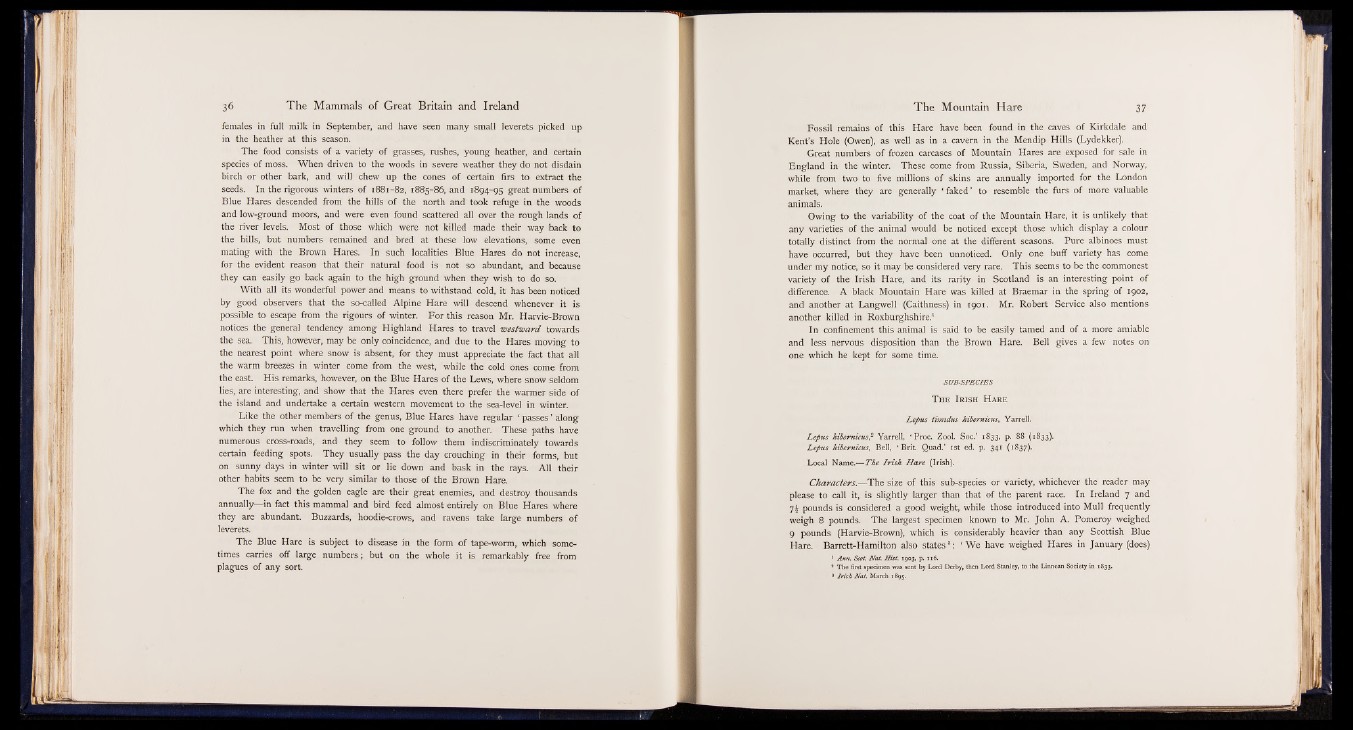
females in full milk in September, and have seen many small leverets picked up
in the heather at this season.
The food consists of a variety of grasses, rushes, young heather, and certain
species of moss. When driven to the woods in severe weather they do not disdain
birch or other bark, and will chew up the cones of certain firs to extract the
seeds. In the rigorous winters of 1881-82, 1885-86, and 1894-95 great numbers of
Blue Hares descended from the hills of the north and took refuge in the woods
and low-ground moors, and were even found scattered all over the rough lands of
the river levels. Most of those which were not killed made their way back to
the hills, but numbers remained and bred at these low elevations, some even
mating with the Brown Hares. In such localities Blue Hares do not increase,
for the evident reason that their natural food is not so abundant, and because
they can easily go back again to the high ground when they wish to do so.
With all its wonderful power and means to withstand cold, it has been noticed
by good observers that the so-called Alpine Hare will descend whenever it is
possible to escape from the rigours of winter. For this reason Mr. Harvie-Brown
notices the general tendency among Highland Hares to travel westward towards
the sea. This, however, may be only coincidence, and due to the Hares moving to
the nearest point where snow is absent, for they must appreciate the fact that all
the warm breezes in winter come from the west, while the cold ones come from
the east. His remarks, however, on the Blue Hares of the Lews, where snow seldom
lies, are interesting, and show that the Hares even there prefer the warmer side of
the island and undertake a certain western movement to the sea-level in winter.
Like the other members of the genus, Blue Hares have regular ‘ passes ’ along
which they run when travelling from one ground to another. These paths have
numerous cross-roads, and they seem to follow them indiscriminately towards
certain feeding spots. They usually pass the day crouching in their forms, but
on sunny days in winter will sit or lie down and bask in the rays. All their
other habits seem to be very similar to those of the Brown Hare.
The fox and the golden eagle are their great enemies, and destroy thousands
annually— in fact this mammal and bird feed almost entirely on Blue Hares where
they are abundant. Buzzards, hoodie-crows, and ravens take large numbers of
leverets.
The Blue Hare is subject to disease in the form of tape-worm, which sometimes
carries off large numbers; but on the whole it is remarkably free from
plagues of any sort.
Fossil remains of this Hare have been found in the caves of Kirkdale and
Kent’s Hole (Owen), as well as in a cavern in the Mendip Hills (Lydekker).
Great numbers of frozen carcases of Mountain Hares are exposed for sale in
England in the winter. These come from Russia, Siberia, Sweden, and Norway,
while from two to five millions of skins are annually imported for the London
market, where they are generally * faked ’ to resemble the furs of more valuable
animals.
Owing to the variability of the coat of the Mountain Hare, it is unlikely that
any varieties of the animal would be noticed except those which display a colour
totally distinct from the normal one at the different seasons. Pure albinoes must
have occurred, but they have been unnoticed. Only one buff variety has come
under my notice, so it may be considered very rare. This seems to be the commonest
variety of the Irish Hare, and its rarity in Scotland is an interesting point of
difference. A black Mountain Hare was killed at Braemar in the spring of 1902,
and another at Langwell (Caithness) in 1901. Mr. Robert Service also mentions
another killed in Roxburghshire.1
In confinement this animal is said to be easily tamed and of a more amiable
and less nervous disposition than the Brown Hare. Bell gives a few notes on
one which he kept for some time.
SU B -SPE C IE S
T he Irish Hare
Lepus tim idus hibem icus, Yarrell.
Lepus hibem icus,2 Yarrell, ‘ Proc. Zool. Soc.’ 1833, p. 88 (1833).
Lepus hibem icus, Bell, ‘ B r it Quad.’ 1st ed. p. 341 (1837).
Local Name.— The Ir ish H a re (Irish).
Characters.— The size of this sub-species or variety, whichever the reader may
please to call it, is slightly larger than that of the parent race. In Ireland 7 and
7£ pounds is considered a good weight, while those introduced into Mull frequently
weigh 8 pounds. The largest specimen known to Mr. John A. Pomeroy weighed
9 pounds (Harvie-Brown), which is considerably heavier than any Scottish Blue
Hare. Barrett-Hamilton also states8: ‘ W e have weighed Hares in January (does)
1 Ann. Scot. N at. H ist. 1903, p. 116.
* The first specimen was sent by Lord Derby, then Lord Stanley, to the Linnean Society in 1833.
3 Irish N at. March 1895.